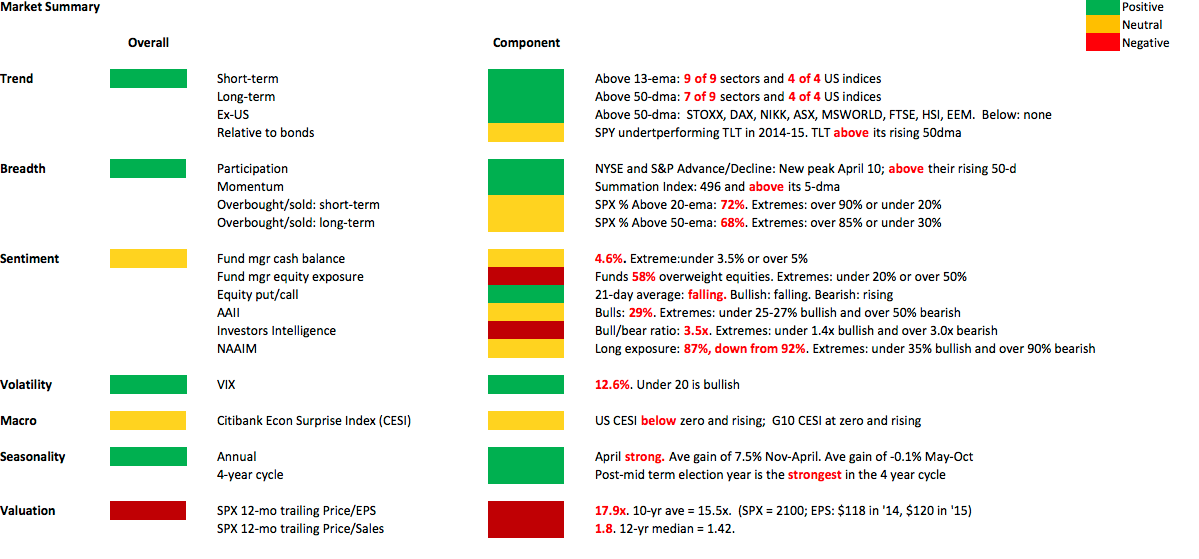Summary: US markets once again look set-up to continue higher, as they have multiple times in the past four months. Each time in the past, however, they have instead reversed lower. Equities may continue higher this week - they are not overbought - but it seems unlikely that the largely trend-less environment has ended once and for all. Sentiment and volatility suggest unfavorable risk/reward on a one-month timeframe.
Following the disappointing NFP release, equities rebounded strongly. For the week, S&P 500 and Dow Jones 30 were up 1.7%. Nasdaq led, gaining 2.5%. The leader the past few weeks, Russell, has become the laggard, gaining just 0.7%.
Once again, ex-US markets were even stronger. Both Europe and emerging markets gained nearly 4%.
Rebounding optimism on worldwide growth contributed to a nearly 5% rise in crude. This was a tailwind for US equities.
There was a potential change in market character this week. SPY rose 3 days in a row for the first time since February 18 (recall that it rose for another two weeks). Moreover, in 4 of the past 5 weeks, the high has been made on a Monday and the markets sold off the rest of the week. This week, in comparison, the low was at the open on Monday and the markets gained the rest of the week.
In other words, the markets are showing less weakness and indecision and more strength for the first time in more than a month.
The question is, will there be follow through higher. And the bottomline is this: US equities have been set up for higher prices, just as they are now, multiple times over the past four months and each time they have instead reversed lower. It's possible equities move higher this week but it seems unlikely that the period of sideways, trend-less trading has come to an end.
Let's review the indices.
RUT closed the week back at its late March ATH; this might be resistance at the start of next week. The trend in RUT is clearly higher, but the advance is getting lethargic. The candles over the past 2 weeks overlap each day and momentum is barely positive (top panel). Price is in the middle of a rising wedge. On weakness, support from the wedge bottom rail is 2% lower, near 1240.
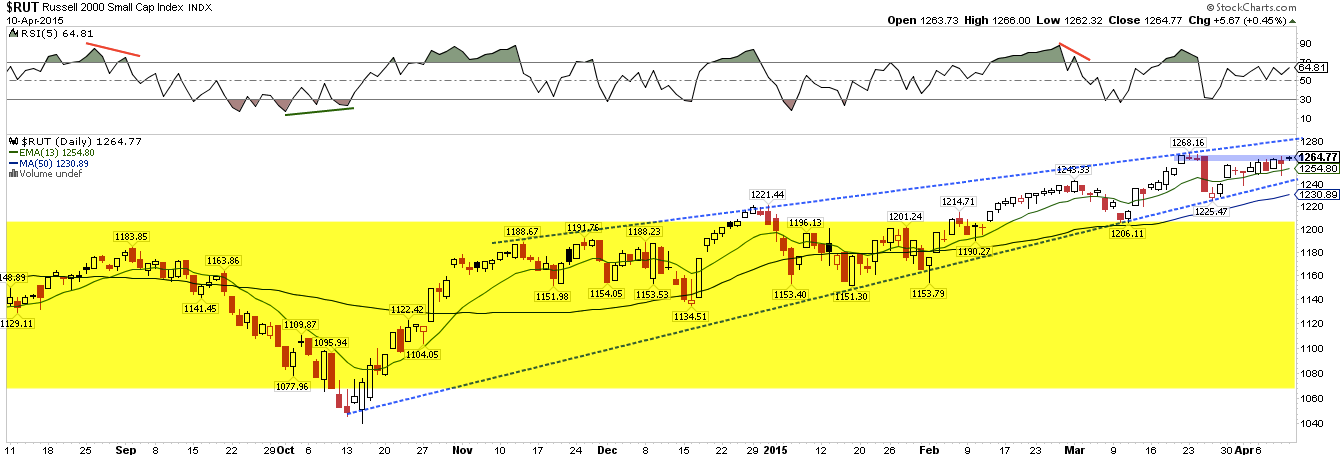
On a longer term view, RUT is up against a 15 year trend line connecting the highs in 2000, 2007, 2014 and recent weeks. This might be a reason RUT's advance is slowing. Of note is that small cap outperformance wanes after April.

Like RUT, NDX is also trending higher; Monday's low successfully backtested the November-February trading zone (yellow in chart below). While this is positive, NDX is now nearing the top of the past two months trading range.
So can NDX continue to new highs? In the past 4 months, uptrends have ended when RSI reached Friday's level (top panel and arrows). The one exception was late February, and all of those gains were given back quickly in March. This means that a test of strength is close at hand. Bullish markets become and remain overbought, trend-less ones fail at moments like these and that has been the pattern since December.
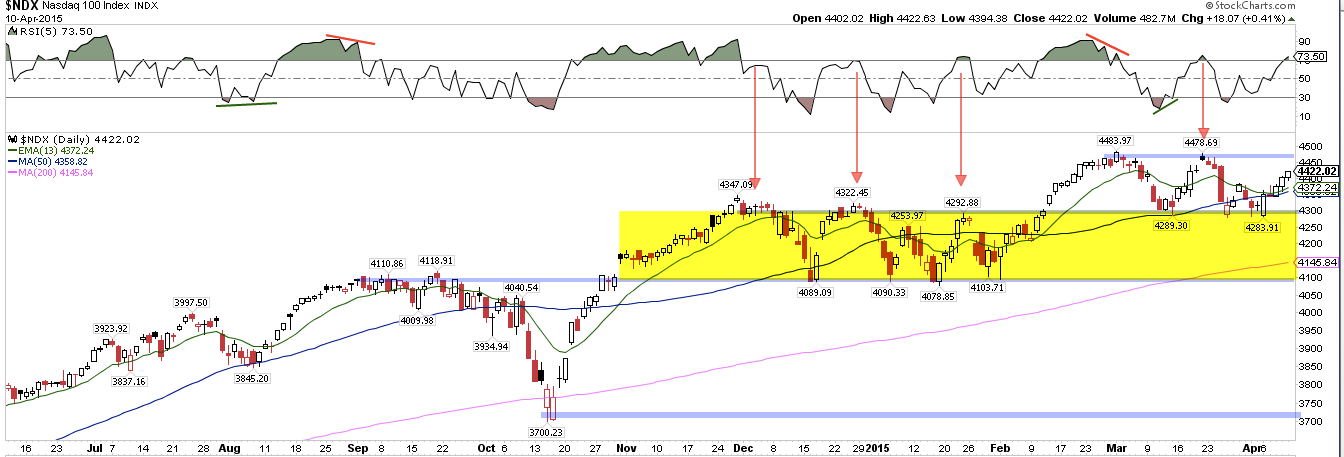
Like RUT, DJIA also ended the week at potential resistance, formed from the series of lower highs over the past month (dashed line in chart below). The index benefited greatly from GE, which rose 14% this week.
DJIA is largely trend-less; Friday's close is nearly dead flat with year-end 2014. Like NDX, a test of strength has arrived; there is almost 4% upside to the one-year trend line above if DJIA can become (and stay) overbought.
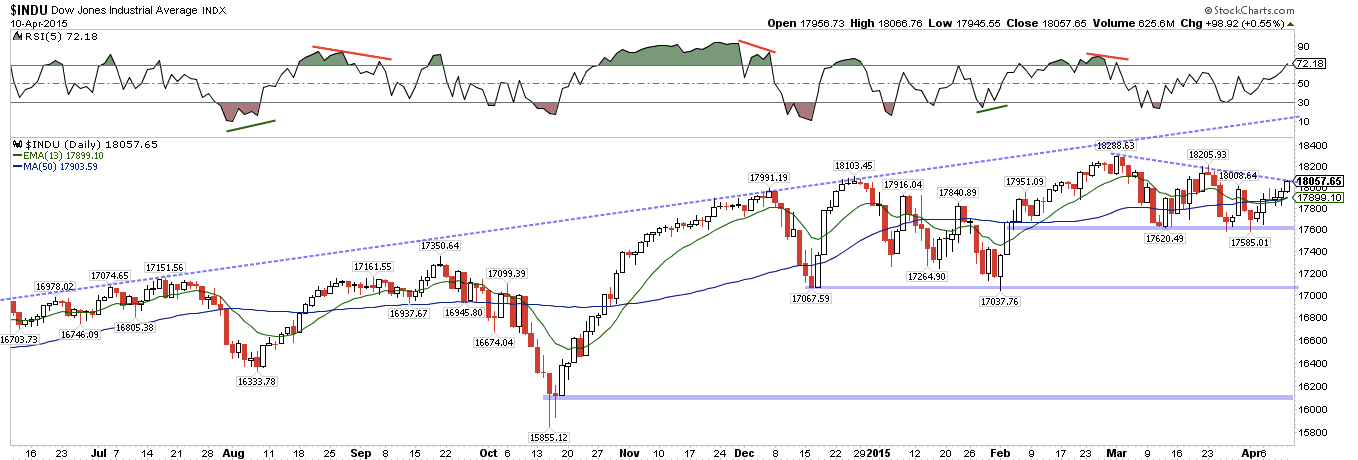
Which bring us to SPY. Like RUT and DJIA, SPY ended the week at potential resistance from March (dashed line). It's above its November-February trading range (yellow), a positive, but it's also fairly trend-less: lower highs and only marginally above where it began the year.
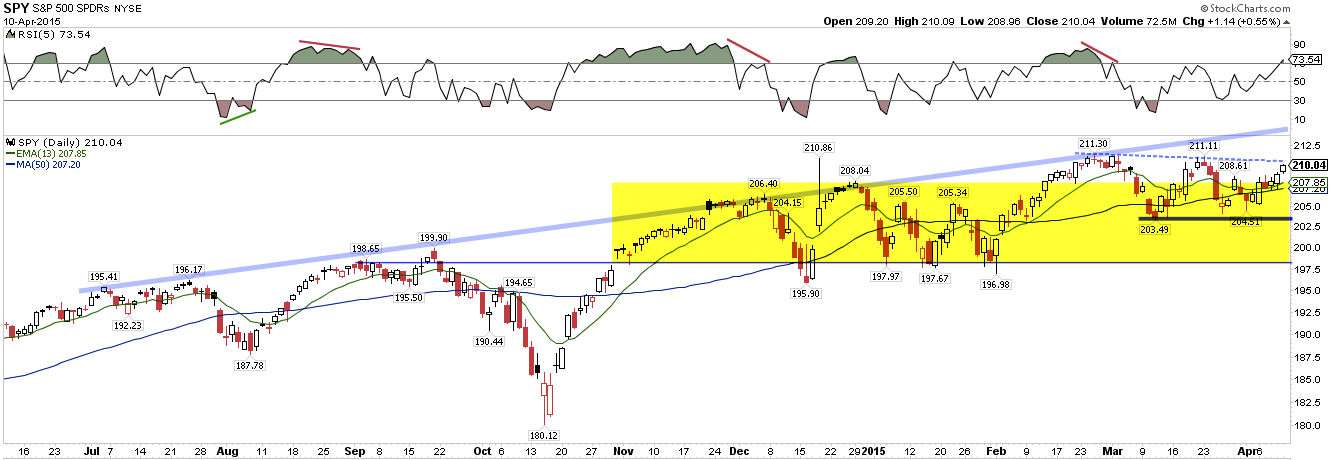
Like the others, the key is whether SPY can become (and stay) overbought, something it hasn't done very much in 2015. If it can, upside is at least 2% higher (to the top trend line) near the monthly R2 (214.6).
Breadth is not overbought. In fact, the pattern in 2015 is for the market to drop at successively lower highs in breadth (bottom two panels). In other words, the same pattern of being unable to become overbought is seen in breadth. It's not clear why this time would be different unless there is a change of market character. If that is the case, then US equities would not be overbought until they had risen several percentage points further.

On balance, investors seem prepared for equities to move higher. This is a negative. On Friday, the ISE equity call/put ratio reached one of its highest levels in the past two years. Most often, SPY has traded sideways in the following days and weeks; any gains have been given back. In the best case (in green), SPYgained about 2% in the next 3 weeks before losing all of it and more in December. In the past 3 cases, SPY has traded lower almost immediately. Again, has the market's character reached a point of change (data from Sentimentrader)?
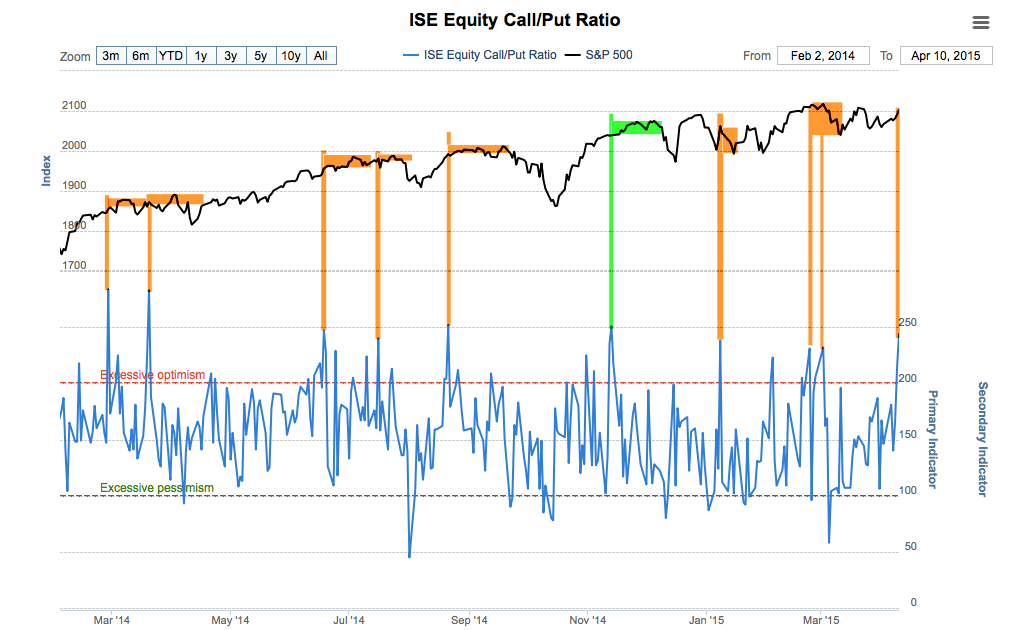
The volatility index, VIX , is sending a similar message. On Friday, the Vix closed nearly 2 standard deviations from its 20-period mean (it's lower Bollinger band). This has most often been a set up for an increase in volatility (middle panel) and a lower SPY (top panel). There are exceptions (May 2014, show in in green). In February of this year, Vix also fell; SPY rose less than 1% in the next weeks before dropping significantly. Most often, risk/reward has been poor over the next month.
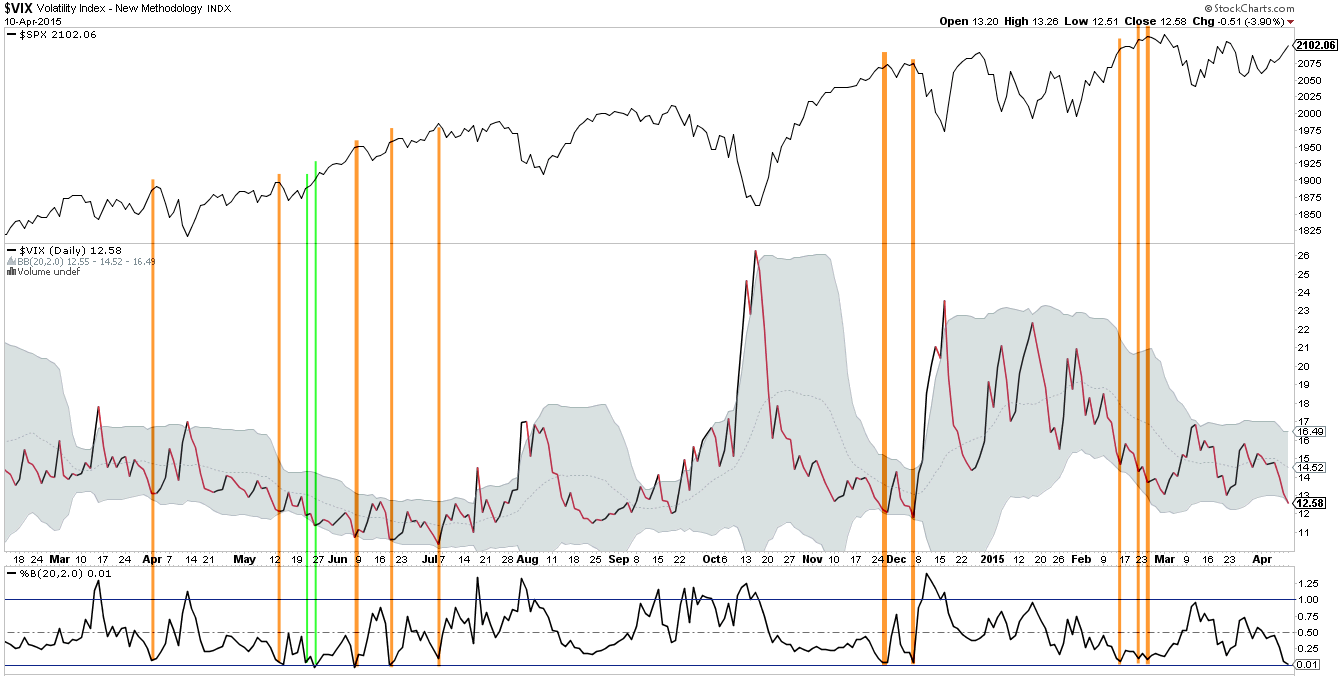
The decrease in volatility can also be seen directly in SPY. The lower panel shows the width of SPY's Bollinger bands. They are as tight now as they were in early December before a 5% fall in SPY. The typical pattern is a move to the lower Bollinger band, now 2.5% below Friday's close. It doesn't always move lower right away; in July 2014, SPY gained less than 2% in the next few weeks before dropping 4%.

In the very short-term, SPY enters the week very overbought. It's hourly RSI(5) was over 90 on Friday (top panel). In the past, any immediate gains have been given back; most often, SPY traded sideways or lower. This has also been a prelude to a reversal lower in SPY (curved arrows). Note the weekly pivot is 208.5 with the rising 13-ema at 208.
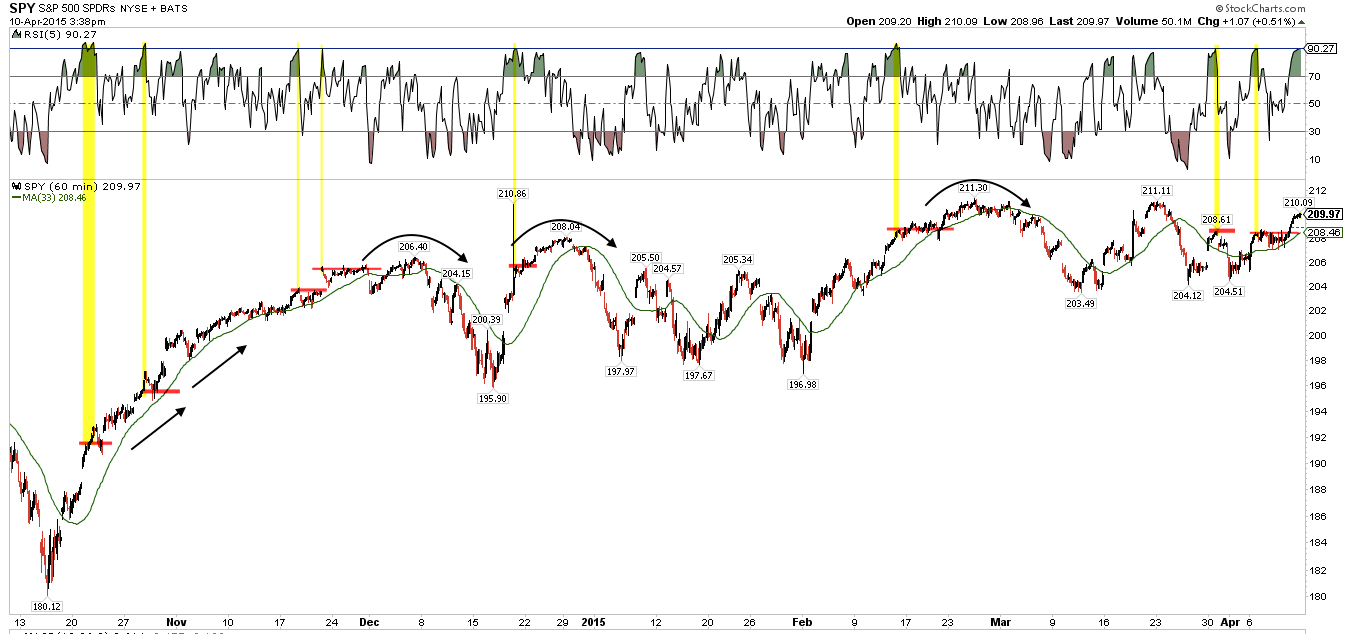
Options expire this week. April OpX is one of the most favorable OpX weeks of the year. In the past four years, equities have entered April OpX at a low; this year, equities are instead at a high (data from Rob Hanna).

In summary, equities are not overbought on a daily timeframe and the trend looks favorable, precisely the set up at prior reversals lower. To move higher, a change in market character will be needed, something which hasn't happened so far in 2015. Even if equities rise this week, the most likely scenario is that these gains will be given back in the month ahead.
Our weekly summary table follows.
